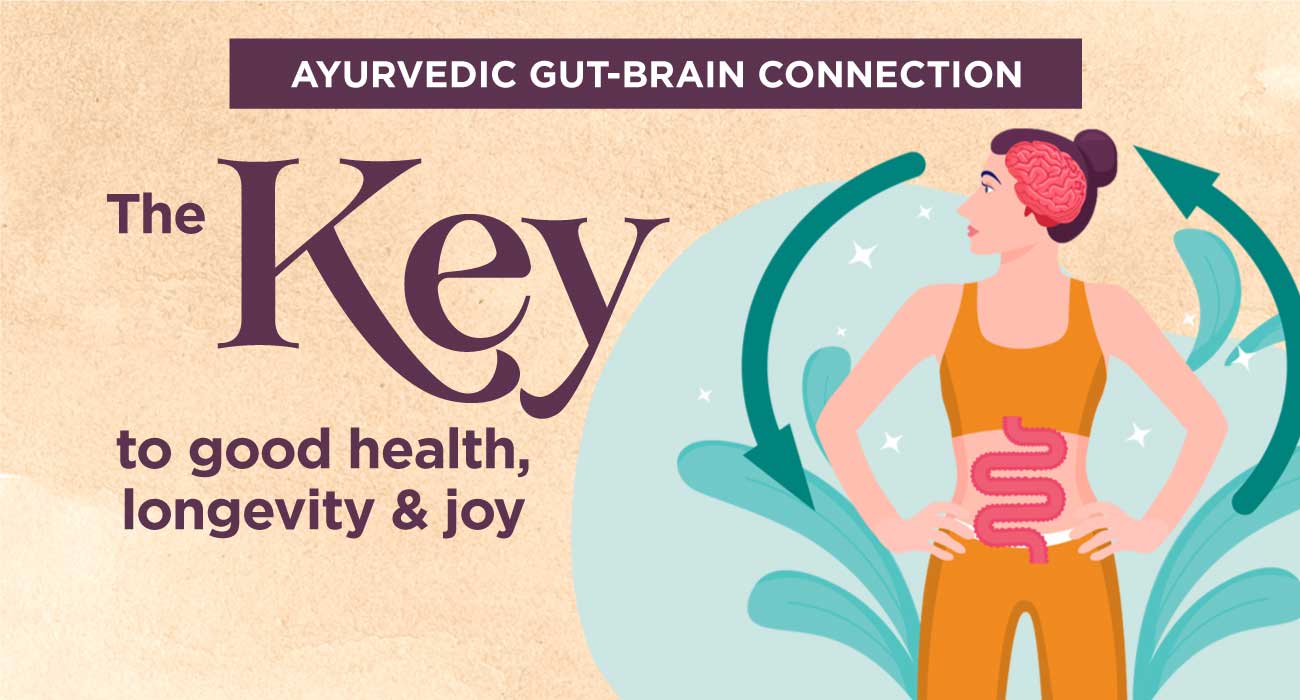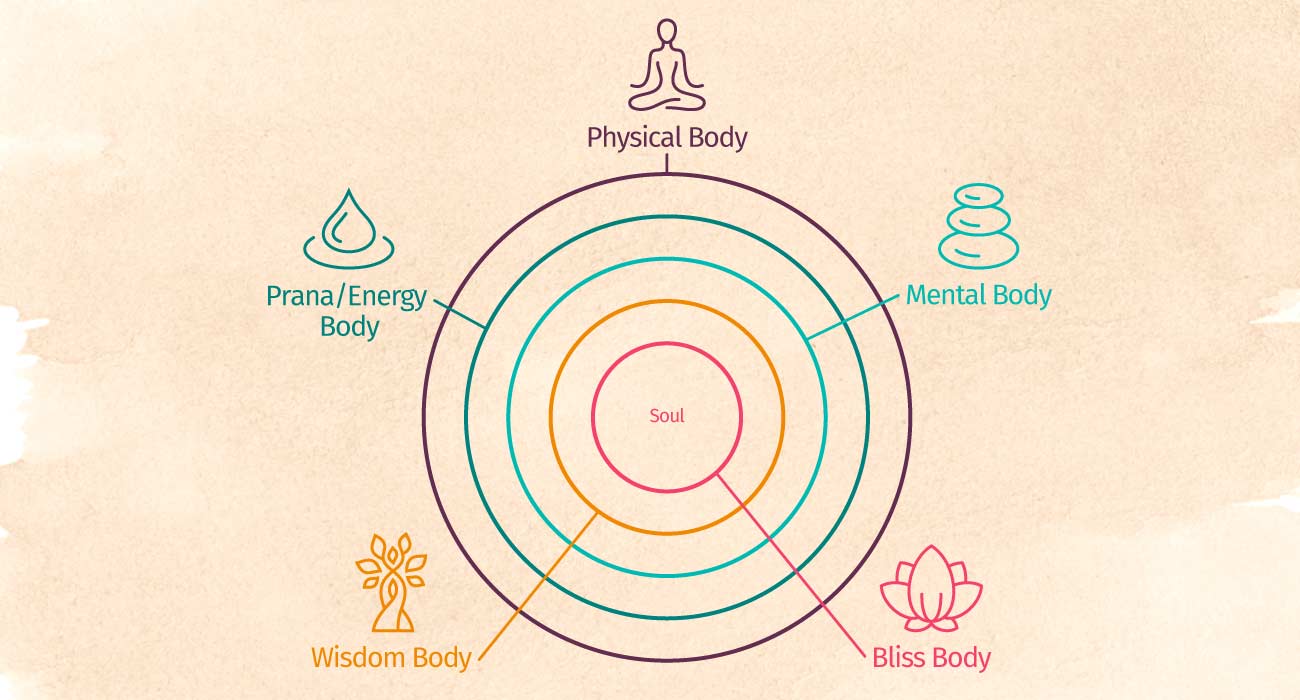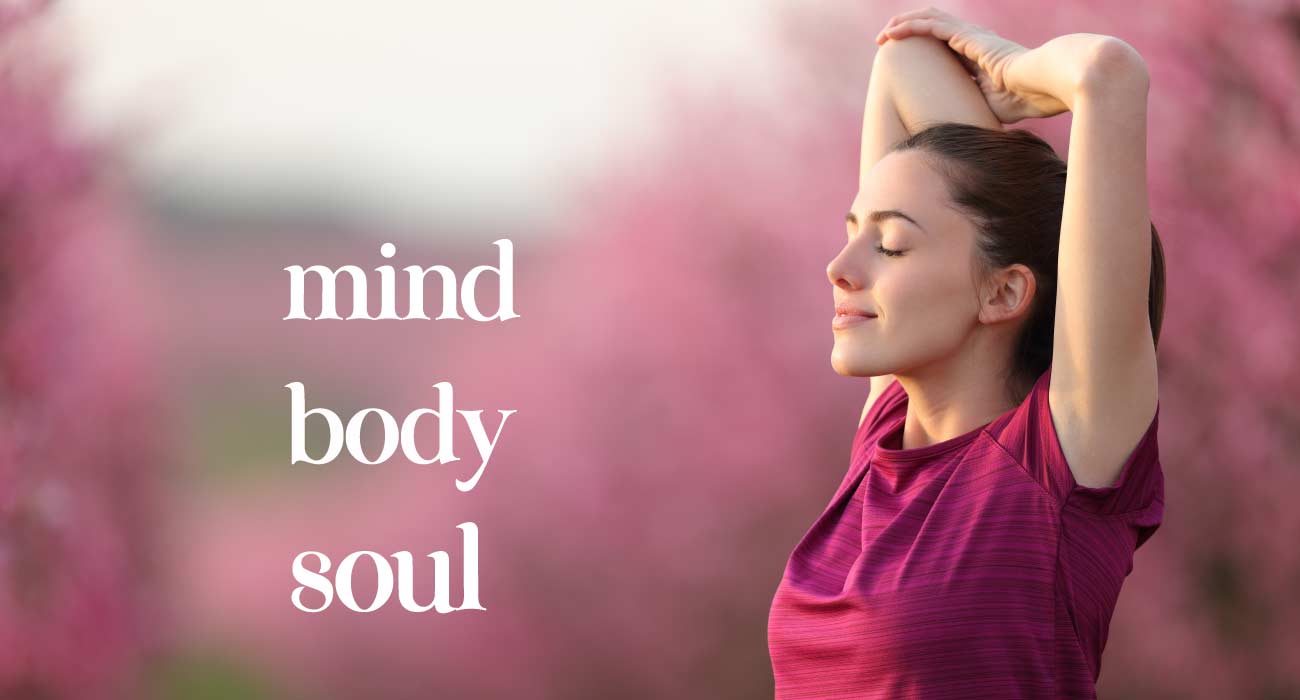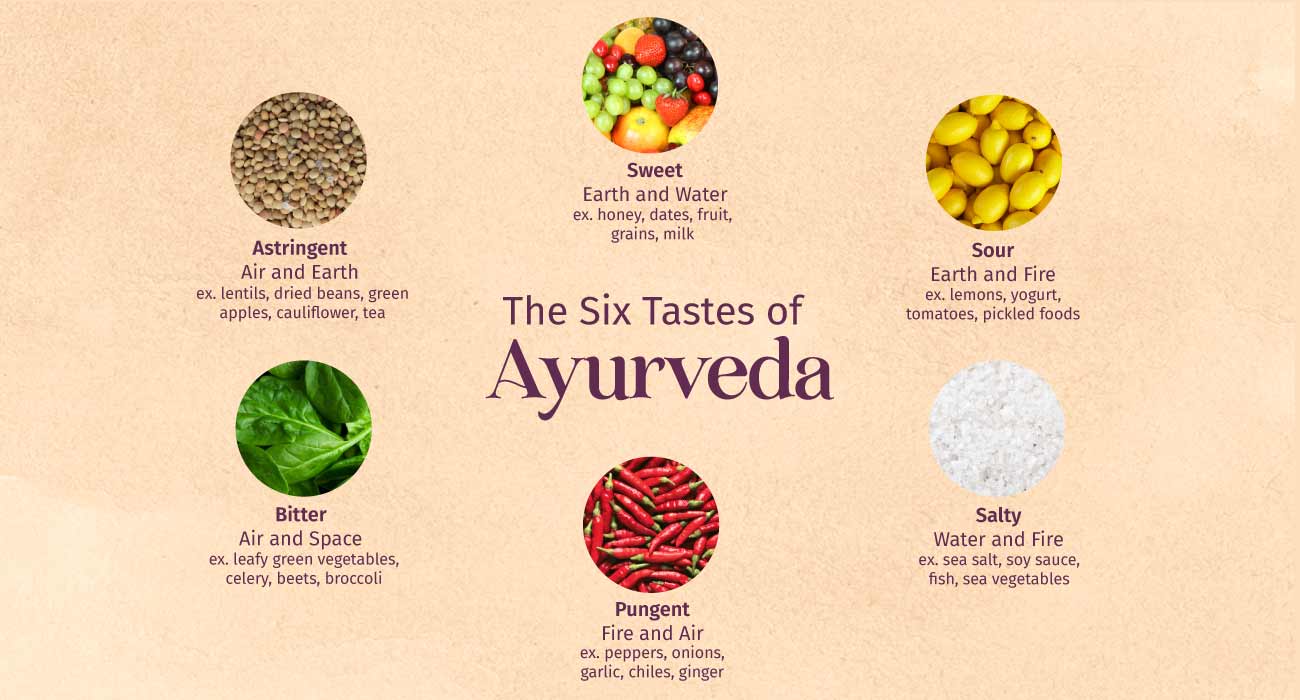
6 min read

Dr. Kulreet Chaudhary
What Is Ayurveda?
Ayurveda is the traditional medical system of India and one of the oldest surviving healing systems in the world (at least 5,000 years old). “Ayu” means life and “veda” means knowledge, so Ayurveda is the knowledge of life. It’s based on the philosophy that good health depends on the balance between the mind, body and spirit. Ayurveda deepens your connection to who you are and aligns you with the natural world. The practice of Ayurveda is a journey towards greater self-awareness and balance so you’re able to make healthier decisions about your life.
Ayurveda is based on three fundamental concepts:
- Food is medicine.
- Disease can be prevented and eradicated by changing daily habits.
- Lifestyle recommendations are based on an individual’s dosha, or mind-body type.
Ayurveda defines health as the presence of certain attributes such as vitality, joy, peace, mental flexibility, emotional stability, immunity, healthy digestion and resilience rather than just the absence of disease. The absence of disease is the first step towards health, but the goal of Ayurveda is mental, physical, social and spiritual balance. Health is the state of thriving, not surviving.
The Basic Principles of Ayurveda
Ayurveda sees the basis of all life as derived from the five elements of nature: Earth, Water, Fire, Air, and Space, which are organized into the three doshas: Vata (Air and Space), Pitta (Fire and Water) and Kapha (Earth and Water). All of us have characteristics of each dosha type, but one dosha is usually most dominant, one secondary and the third least prominent. Disease is caused by an imbalance in Vata, Pitta or Kapha, which results in cellular dysfunction. Creating total (physical, mental and spiritual) balance requires an understanding of how these three doshas work together in the body.
One of the distinctions in Ayurveda is to not identify yourself as only your body, but rather as a relationship between the body, mind and spirit. Your mind is one of the biggest influences on your body. Healing the body always involves healing the mind. Focusing on just the body is a long, frustrating, uphill journey. Ayurveda helps you shift the mind away from negative thought patterns and connect to your spirit to help heal the body.
Below is an overview of each dosha. If you don't know which you are, take my Dosha Quiz to find out.
Vata is a combination of space and air and represents movement. People with a predominant Vata dosha tend to be small-framed, thin and light. Their skin tends to be dry and rough. They are physically very active and find balance through sweet, sour and salty tastes and are aggravated by the pungent, bitter and astringent tastes. Vata tends to be less tolerant of cooler weather and frequently experiences cold hands and feet.
Vata governs activities such as breathing, blinking, movement of muscles and tissues, beating of the heart and movement within cells. When balanced, Vata is quick to catch on to things and highly creative, enthusiastic and intuitive. Out of balance, Vata can be nervous and may experience insomnia, constipation and anxiety. It’s the mood-swing dosha! Vata benefits more than any other dosha from a calm and regular routine. Warm, rich foods and calm situations balance Vata.
Pitta is a combination of fire and water and represents digestion and metabolism. Physically, Pitta is of average build with a medium, muscular frame and is naturally athletic. Pitta is a high achiever, ambitious and driven. Pitta is balanced by sweet, bitter and astringent tastes and aggravated by sour, salty and pungent tastes. Pitta does well with cooling foods that turn down the heat.
Pitta typically experience strong digestion, steady energy and good circulation. Too much Pitta energy can cause anger, jealousy, impatience, irritability, rashes, headaches and an overly reddish complexion. When Pitta gains weight, it tends to be inflammatory weight, with lymphatic accumulation, the most uncomfortable kind of weight.
Pitta really benefits from time in nature. It’s incredibly rejuvenating and calming to Pitta, the perfect remedy for irritation and anger. Pitta also needs to stay cool to balance its hot temperament and cool weather is welcomed. They are often warm in the winter when everyone else is freezing.
Kapha is a combination of water and earth and represents structure and lubrication. They are usually big boned and sturdy and tend to have the most difficulty keeping weight off. Kapha tends to have smooth, luminous skin, glossy dark hair, lovely singing voices and good long-term memory. Kapha is the relaxed, mellow, chill dosha. People who are predominantly Kapha have a let-it-be approach to life. They aren’t prone to stress, anxiety or irritation. Kapha is balanced by pungent, bitter and astringent tastes and aggravated by sweet, sour and salty tastes.
Kapha truly enjoy food and sugar and dairy are weaknesses that only make their imbalance worse. Kapha needs a low-fat, vegan, nutrient-rich, low-calorie diet with reduced fruit intake. When out of balance Kapha can lack motivation and feel too lazy to do anything. A sedentary lifestyle is attractive to Kapha and it really has to be motivated to move around. Kapha is balanced and calm, and in a crisis they are good to have in charge.
Gut-Brain Connection
Ayurveda approaches the mind and body as a whole—there is no part of the mind and body that functions independently. Whatever happens in one part of the mind-body complex impacts the whole. It’s a beautiful system that begins with the acceptance of our inner-connectedness.
Modern medicine is just beginning to grasp this concept, most notably in the research on the impact the gut microbiome has on our overall health, particularly the brain. The term gut-brain connection is often used to explain the intricate relationship between the digestive system and the gut, but this language is limiting because of the assumption that the gut and brain are two different functional parts. When in reality, the gut and brain are ONE functional unit.

When we look at the human being as only the body, it may be difficult to see the gut, which is located way down around our navel, as part of the same functional complex as the brain, way up there in our skull. But in Ayurveda, the physical body only reflects one aspect of the organization of the human body. The physical body is the densest aspect of who we are, which is why we are able to perceive it so easily through our senses. There are other aspects of the human body that are organized as fields of energy, which exert a direct biological impact on the physical body. Although you may not see these fields of energy, you are certainly aware of them, such as the mental body—the source of all thoughts and emotions.
The Five Sheaths—Layers of Being
In fact, in Ayurveda the human body is said to be composed of five bodies that lay upon each other as five sheaths:
- Physical Body
- Energy Body
- Mental Body
- Wisdom Body
- Bliss Body

Each of these five bodies exist as different energy states that communicate with one another. The subtler the energy field, the more powerful the impact it has on the other bodies. The bliss body, which is the subtlest of all the bodies is often experienced during states of deep meditation and has the greatest impact on all the other sheaths covering it. When we compare the influence of the physical body versus the mental body, which is the source of all of our thoughts and emotions, the mental body carries much more influence on overall health than the physical body alone. This is why, as modern research shows, stress impacts our physical health so powerfully.
There are areas where the subtler bodies intersect with the physical body to become a functional unit. The mental body intersects with the digestive system through an energy channel or chakra called the solar plexus, to become an inseparable functional unit. From this higher organizational perspective of the human body, you cannot say that there is a gut-brain connection because the gut and brain are actually one functional energy unit operating together in unison.
What This Means for Mental Health and Gut Health Concerns
To resolve either issue—mental or digestive—you need to address both the mind and the gut simultaneously. When you have toxins in your gut, it shows up in your thought patterns, which can lead to conditions such as depression and anxiety. And when you have chronic negative thought patterns, it influences your gut health. There’s evidence of the functional gut-brain unit when a patient is releasing past trauma. During the processing of the trauma patients will often experience acute gut symptoms due to the activation of the autonomic nervous system. And a patient with chronic gut issues will feel a sudden relief from anxiety or depression when digestion improves due to the impact of the microbiome on brain health.
I’ve had countless patients with small intestinal bacterial overgrowth (SIBO) or other chronic gut issues where the cause of their digestive problems were rooted in unprocessed trauma. One patient had a 20-year diagnosis of chronic giardiasis and SIBO. She did everything imaginable to heal her gut over the years with some partial improvement in her digestive health. It was evident that there was significant unprocessed trauma from her father abandoning her in early childhood. She just never thought to address that trauma as part of her gut issue.
Since she already had done so much for her digestive health, we focused predominantly on releasing the unresolved trauma through the use of herbs, meditation and sound healing. Within a few months her gut issues began to spontaneously resolve and more importantly a life-long subconscious pattern of mental anguish finally lifted.
The beauty of accepting the inseparable unit of the gut and brain is that as you manage both simultaneously, you are bringing into balance the two most important systems in the body, which govern your entire health landscape. But when you only address one system—either the gut or the brain—you can spend years traveling down a singular path with only partial improvement because the other functional part of the unit has been ignored.
The Mind Has the Power to Heal
The mind-body-soul connection isn’t something you have to go out and buy. It already exists inside of you—you were born with it. You’re aware of the body—you live in it and when it gets sick you really become aware of it. Most of us are also aware of the mind—that “thing” in your brain that projects a constant stream of thoughts and emotions into your day. Even doctors are becoming more aware of the connection between the mind and the body. Studies show people who suffer from problems of the mind, such as depression, are at a higher risk for other chronic diseases. You may have noticed that when you’re under more stress, you’re more susceptible to catching a cold.
Whether you are conscious of it or not, your mind is always having a conversation with your body as a biochemical reaction. We’ve all experienced this. Have you heard some very bad news and suddenly felt sick to your stomach? This is an example of the mind-body connection. If a doctor measured your blood pressure, heart rate and specific hormones before and after the bad news, you could actually measure the impact the negative thought had on your body. The same is true for good news, but in the opposite direction. Happy thoughts can actually create happy biochemistry. When you become conscious of the mind-body connection, you bring awareness to the subconscious patterns that control biology. It’s through this awareness that you can change these hidden patterns to catalyze healing.
The soul is the invisible, intangible part of our lives that connects us to something bigger than what we see in the mirror. It is the part that joins our intellect to a greater universal intellect that connects everyone and everything. Quantum physicists have described it best as a web of energy or “divine matrix” that connects everything in the universe through fields of energy.
When we disrupt that field through chronic violent activities, such as repetitive negative thoughts about ourselves or others, it is the equivalent of putting a drop of poison into that web. This web is connected to our mind and body and eventually toxins can manifest as depression or physical ailments. This is where we get that saying “what goes around comes around.”

How We Can Maximize the Mind-Body-Soul Connection
Unless you have absolutely no complaints in your life, we all have room for improving the mind-body-soul connection to live healthier, more joyful lives. You may think your problems are coming from your job, spouse, kids or health. But these are all just projections on a movie screen that are showing you the current state of your mind-body-soul connection.
A cheap, calorie-free technique for boosting the mind-body-soul connection is to train yourself to complain less about what’s wrong in life by implementing a mindfulness practice that focuses on gratitude for what is going well. It’s the glass half full versus half empty approach. Chronic complaining can drain your energy and weaken your ability to strengthen the mind-body-soul connection. Gradually reduce negative conversations, gossip and criticism by creating a mindfulness practice to find just one thing to be grateful about even in seemingly unfavorable situations. The little bit of gratitude changes the energy from something that is poisonous to something nourishing to the mind, body and soul.
How Ayurvedic Medicine Benefits Us
Ayurveda offers a very specific and concise map for your health. Just as you have a unique fingerprint, you have a particular energy pattern—an individual combination of physical, mental and emotional characteristics —which comprises your mind-body map. Rather than recommending all things for all people, Ayurveda is a system that very carefully prescribes actions for specific states of imbalances. It takes into consideration seasonal changes as well as lifestyle changes and how these impact your individual mind-body map, or dosha. Since Ayurveda is so tailored to your individual needs, it’s effective at tackling a broad array of physical and mental health issues with recommendations tailored specifically for you.
In Ayurveda, the seasons and the doshas correspond with each other. There are three seasons each year, each represented by the three doshas, Vata, Pitta and Kapha. Vata season is in the fall and early winter, when it is cool and dry. Kapha season is during late winter/early spring when it is cold and wet. Pitta season is late spring through summer, when it is hot. Each season ignites the dosha energies within us, and our systems can be thrown out of balance if we don’t adapt to the weather. It’s important to remember that your predominant dosha increases during the season it governs, so choose foods and activities that will balance it, not aggravate it.
The Six Tastes of Ayurveda
Ayurveda sees taste, as a powerful therapeutic tool that determines not only how we experience our food, but the effect that various foods, spices and therapeutic herbs will have on our state of balance—mind, body and spirit.
Ayurveda recognizes six tastes—sweet, sour, salty, pungent, bitter and astringent—each of which plays a vital role in our physiology, health and well-being. Each of six tastes contains two of the five elements:
- Sweet—Earth & Water
- Sour—Earth & Fire
- Salty—Water & Fire
- Pungent—Fire & Air
- Bitter—Air & Space
- Astringent—Air & Earth

And each taste has a particular impact on each of the three doshas —Vatta, Pitta and Kapha. The combination of tastes that’s right for you depends on your mind-body blueprint, your imbalances, your age and your environment. And it may change over time.
Self-Care Ayurvedic Healing Traditions
Ayurveda is a treasure chest of natural remedies that promote longevity, beauty and vitality. Here are eight of my favorite Ayurvedic practices and herbal remedies.
Sound Medicine
In Ayurveda, specific sounds are used to balance the mind and body, maintain good health and support healing. Different types of sound impact the human body and brain uniquely and have positive physiological effects from altering our mood to healing disease.
Daily Oil Pulling (kavala or gundusha)
Oil pulling is an ancient method of detoxification that has a multitude of positive effects on your body. In addition to improving oral health, oil pulling cleanses all the internal organs of your body and it’s easy to do with no side effects. Some commonly treated conditions include: acne, allergies, arthritis, asthma, bronchitis, chronic fatigue, colitis, Crohn's Disease, constipation, dental cavities, dermatitis, diabetes, eczema, hemorrhoids, hypertension, insomnia, migraine headaches, mucous congestion, PMS, sinusitis, peptic ulcers, periodontal disease, bleeding gums and tooth abscess.
Oil pulling is very simple and easy. Take 1 tablespoon of cold-pressed or refined, organic sesame or coconut oil in the morning and swish it around in your mouth for 10-20 minutes then spit it out. It’s best to do the oil pulling first thing in the morning on an empty stomach or right before going to bed. Make sure not to swallow any of the oil, as it contains toxins that have been removed from your body. To be time efficient in the morning, begin swishing the oil and then take your shower while you continue the oil pulling. After you’re done, spit the oil out and brush your teeth and scrape your tongue. You should see an increase in the coating on your tongue after the oil pulling. If you like, you can also do a warm salt-water rinse of your mouth after you have finished brushing your teeth.
Dry Brushing Massage (garshana)
Garshana is a traditional Ayurvedic dry brushing massage done before bathing that stimulates the lymphatic system and exfoliates the skin, enhancing blood circulation and the release of accumulated toxins. It's traditionally done using raw silk gloves, but many people prefer using a natural bristle body brush. It's easy to learn and incorporate into your daily routine.
Oil Massage (abhyanga)
We tend to think of only getting massages on special occasions. But you can treat yourself as often as you want to a warm oil massage in the comfort of your own home. This daily oil massage helps reduce stress, keeps your skin youthful and boosts immunity. For the majority of people, the best oil to use is organic, cured sesame oil. But if you produce a lot of body heat, tend to get rashes easily or are susceptible to inflammatory conditions, organic coconut oil is a better choice.
Essential Ayurvedic Herbs
Curry Powder
There is no reason that eating healthy cannot be delicious and that is the magic of curry powder. It is packed with spices that fight disease and serve as antioxidants while remaining wonderfully appetizing. Ayurveda recognizes six tastes—sweet, sour, salty, bitter, pungent and astringent. The American diet often has plenty of the first three–sweet, sour and salty—but is often missing the last three. Because curry satisfies all six tastes, it helps you eat less at each meal.
One of the nutritional treasures of curry powder is turmeric. It’s a potent antioxidant that protects cells from free radicals and it promotes a healthy inflammatory response. You can use turmeric in curry powder or get it in tablet form to increase your consumption.
Ashwagandha
Ashwagandha is a well-recognized adaptogen, which means it helps your mind and body adapt to stress by making you feel alert and relaxed simultaneously. It helps to strengthen a weakened mind and body as a result of chronic stress, injury and aging. It’s probably best known for its impact on the nervous system, where it exerts a calming and energizing effect. It is also helpful in rejuvenating the reproductive system, which is why it used in Ayurveda to promote sexual potency; it supports the thyroid in hypothyroidism and helps regulate autoimmune conditions, such as rheumatoid arthritis. In today’s fast-paced, high-stress world, ashwaganda offers much needed relief and restoration for the entire body.
Triphala (amalaki / bibhitaki / haritaki)
Triphala is an ancient Ayurvedic herb that is composed of three dried Indian superfruits that work synergistically together: amalaki, haritaki and bibhitaki. Triphala is the most commonly used Ayurvedic herb for gut health and when taken regularly, it produces a deep and enduring cleansing of all the tissues in the body.
Amalaki works as a natural antioxidant that removes excess inflammation from the gut and body. It also helps to increase lean body mass and maintain healthy blood sugar levels. Haritaki supports the body’s natural cleansing process by gently removing toxins that accumulate in the colon. Plus, it helps reduce cholesterol deposits in the bloodstream. Bibhitaki is particularly effective in reducing the accumulation of fat and fluids in the body as well as removing accumulated inflammation in the colon. It supports the formation of a healthy mucous membrane in the colon.
Each one of these herbal preparations has tremendous value individually. However, when they are combined in the form of Triphala they work as an even more powerful tool to detoxify and strengthen the body and heal the gut.
Brahmi (Bacopa monnieri)
Brahmi is the most commonly used herb for the brain. It helps to improve memory, concentration and learning. It’s traditionally used for a number of psychological and neurological conditions, such as Parkinson’s disease, Alzheimer’s disease, ADHD, depression, anxiety and addictions. It helps to relieve an exhausted nervous system. In addition to treating conditions of the mind, it is also used to support intelligence and prevent future conditions like dementia. Brahmi and ashwaganda combined offer potent relief to a tired and overworked mind.
Amla (amalaki)
Amla is one of the great rejuvenating foods in Ayurveda, which is why I try to take it regularly. Although it is a berry, it’s often consumed in powder form as a spice in Indian cooking or in tablet form as an herb. It balances all three doshas and has a naturally sour taste, which is why you can substitute it for lemon in your cooking. It helps with a multitude of conditions, including gastritis, ulcers, hyperacidity, colitis and hemorrhoids. It’s also used to treat cardiac conditions, diabetes and anemia. Amla has 20 times the Vitamin C of an orange and is one of the most potent antioxidants in Ayurveda. In Ayurveda we say, "An amla a day keeps the doctor away."
Ayurveda is a Lifeboat for Modern Life

In many ways I feel that Ayurveda is more relevant today than it was in the past. Today, we are facing more challenges to our physical and mental health than ever before. Without a detailed understanding of our unique mind-body type and an understanding of how different variables in our life can impact it, we can feel like we’re caught in a tsunami without an escape. The gift of Ayurveda is it gives us a road map of why we are the way we are both physically and physiologically. Ayurveda helps us become fluent in the language of our mind and body, so we’ll hear what our body needs and know how to fulfill our needs for a balanced, healthy and happy life.

